The Samsung Galaxy S7 & S7 Edge Review, Part 1
by Joshua Ho on March 8, 2016 9:00 AM ESTSoC Performance
While we’re ready to move on to newer benchmarks for 2016, our system performance benchmarks from 2015 are still going to provide a pretty good idea for what to expect from the Galaxy S7 and Snapdragon 820 by extension. For those that are unfamiliar with what the Snapdragon 820 is, I’d reference our previous articles on the Snapdragon 820.
In essence, we’re looking at a 2x2 CPU configuration with 2.15 GHz Kryo cores for the performance cluster, and 1.6 GHz Kryo cores for the efficiency cluster. Binding the two clusters together are some power aware scheduling at the kernel level and a custom interconnect to handle coherency between the two clusters. Memory is also improved relative to the Snapdragon 810, with a bump to LPDDR4-1866 over the former's LPDDR4-1600. Of course, there's a lot more to talk about here, but for now we can simply look at how the Snapdragon 820 compares in our benchmarks.
Update: As we've had a few questions on the subject, I just want to clarify browser testing. Samsung's stock browser was not included with our Verizon-branded sample phone, nor is it possible to install it at this time. As a result we are unable to test the performance of Samsung's browser. The Verge reports that this is a Verizon decision and that all Verizon phones will be shipping like this; so for these phones Chrome is the de-facto stock browser.
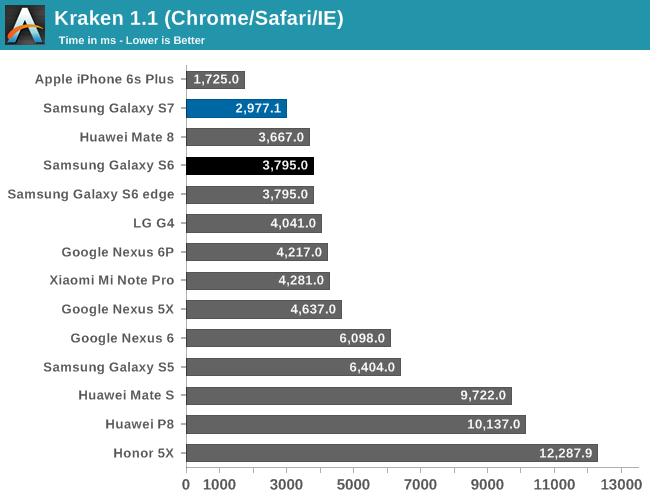

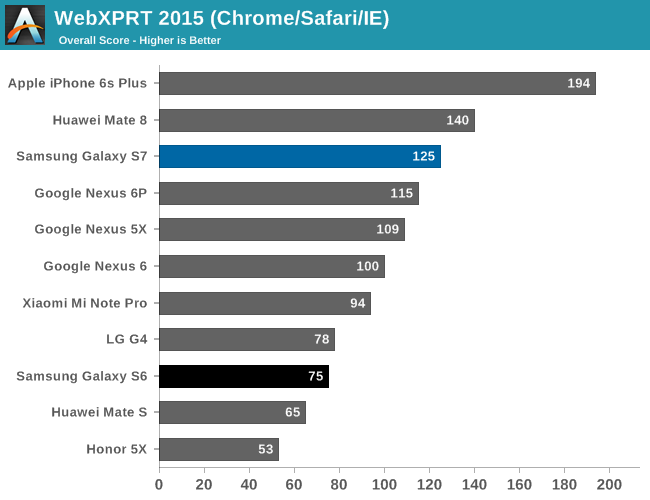
Starting off with our web benchmarks, we can see that in the time since our initial testing of the Snapdragon 820 MDP there have been some major improvements to how well Chrome is optimized for Kryo. As a result we're seeing results that are almost comparable to Snapdragon Browser in Chrome.
Overall then the Galaxy S7 and its Snapdragon 820 SoC won't top the charts on web benchmarks - Apple still holds an edge here - however the Galaxy S7 puts up a solid fight. The one drawback here is that the Mate 8 and its Cortex A72 CPU seems to have the edge over the Galaxy S7.
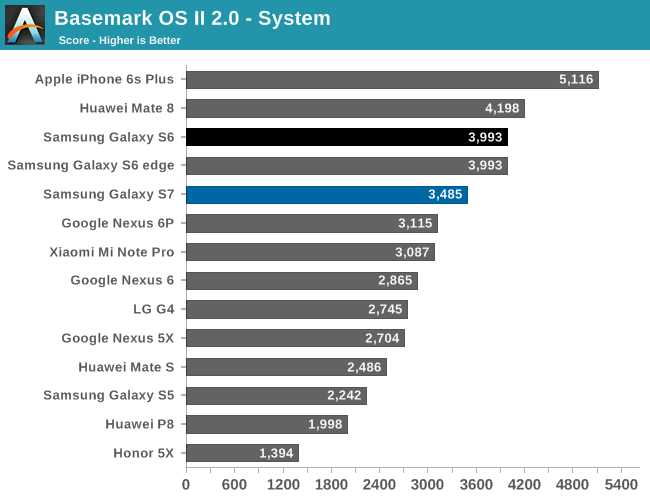
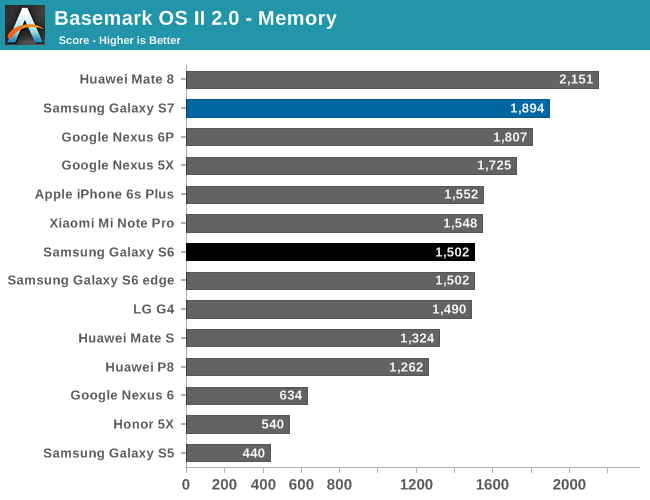
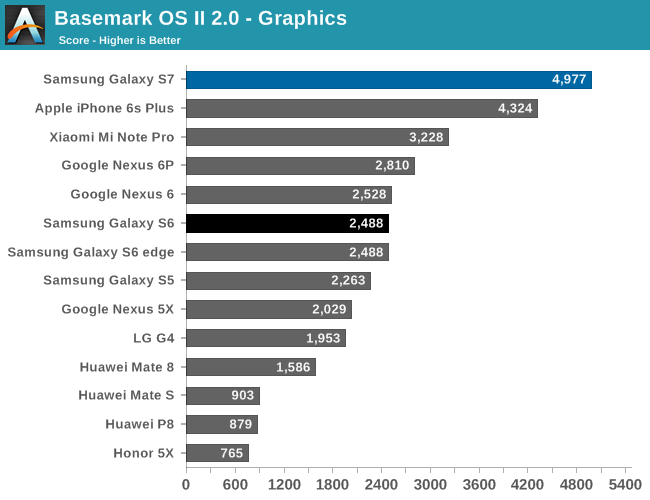
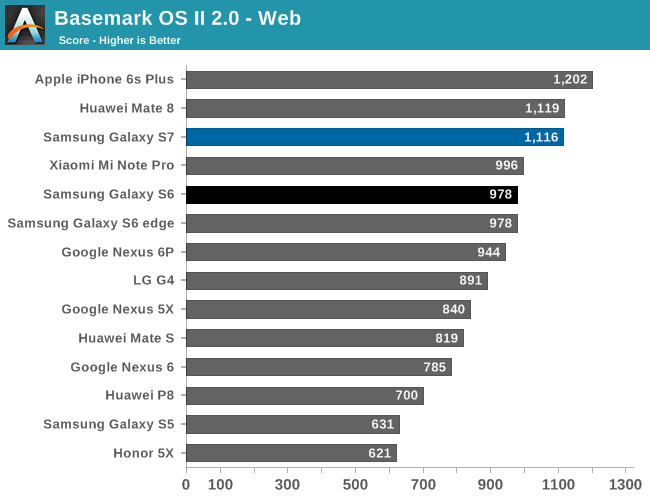
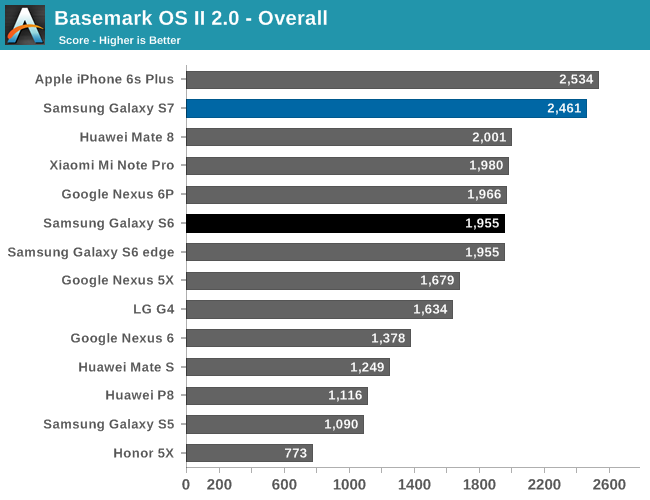
In Basemark OS II the combination of a better GPU, better NAND, and better single thread CPU performance seems to be enough for the Galaxy S7 to approach the iPhone 6s Plus in overall performance. While the system benchmark shows that Kryo isn't quite going toe to toe with Twister, the Adreno 530 helps to narrow the gap in the graphics test.
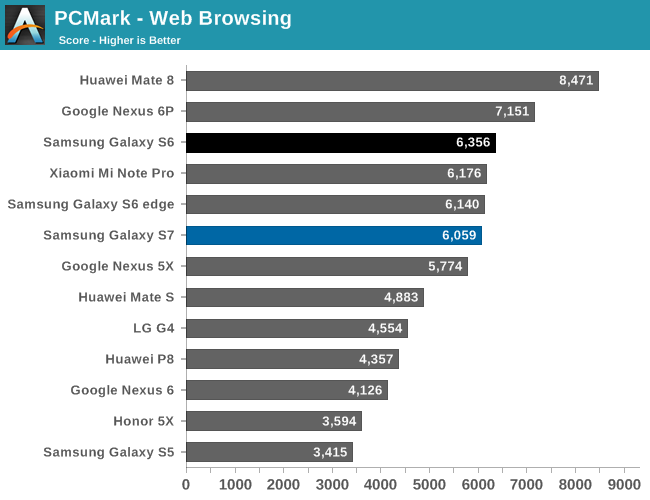
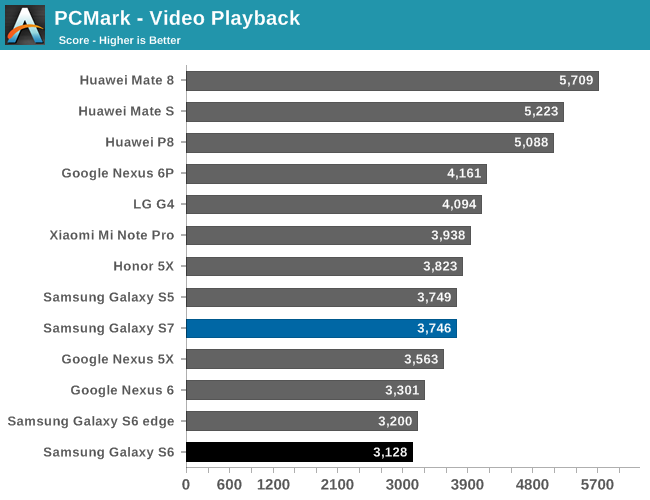


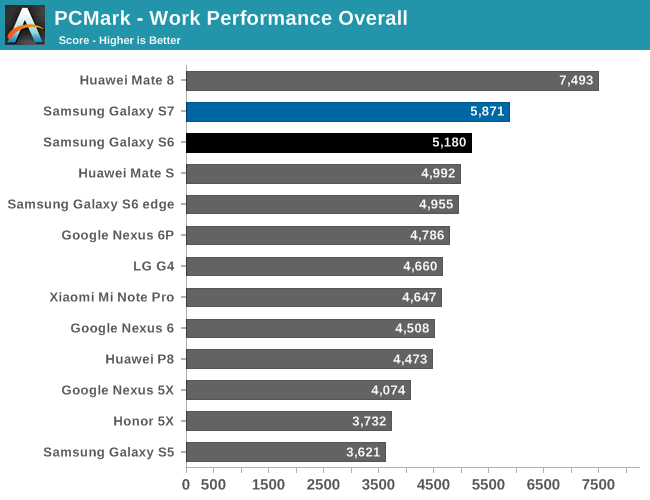
In PCMark, we can see that the Galaxy S7 is mostly comparable to the Galaxy S6. However major improvements in areas like GPU performance help to give it an overall advantage relative to the Galaxy S6 in the photo editing test. Given that this is basically a test of API-level performance, it's likely that Samsung's frameworks and governor settings lead to mostly similar performance in these tests.
Overall, the Snapdragon 820 appears to provide a pretty healthy bump in performance over almost every SoC seen in 2015, although it's hard to declare a clear winner when comparing it to Apple's A9 or Huawei's Kirin 950. If you glanced at the battery life graphs and the performance graphs above it's pretty obvious that Qualcomm has made some enormous strides here. While not quite going from zero to hero, Qualcomm has come close, and that definitely deserves some credit.
NAND Performance
If you think about the memory hierarchy, while RAM and cache are important, at the end of the day the most important aspect is the base storage. Even if you have infinite RAM and cache, if your storage is sufficiently slow the user experience is going to be painful for at least the first time you have to load something.
In order to test this, we use our standard test of AndroBench with 4 KB and 256 KB reads and writes for random and sequential tests. I went ahead and did some digging around to figure out exactly what it is we’re testing in the Galaxy S7, and it turns out that while the Galaxy S7 storage solution is similar to what’s in the Galaxy S6 and S6 edge, it isn’t quite the same. The Galaxy S7 UFS storage identifies itself as the KLUBG4G1CE-B0B1, which looks to be in the same family and appears to have been released at pretty much the same time as the Galaxy S6 storage solution, but the model number isn’t quite the same.
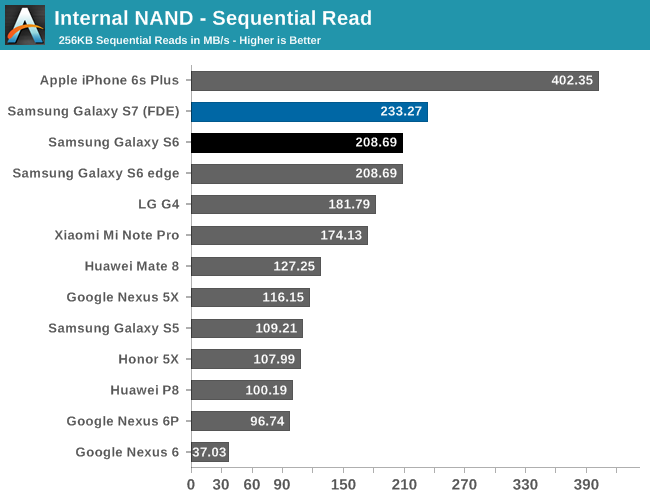
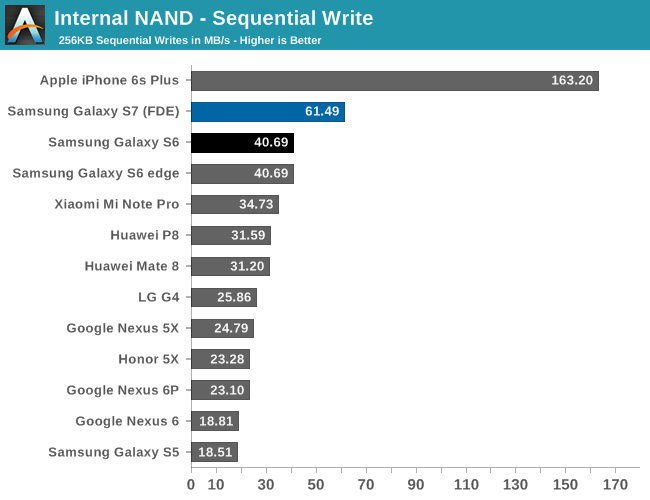
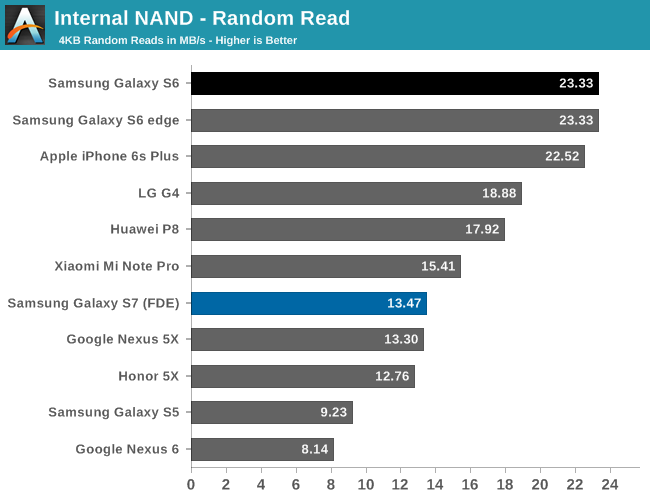
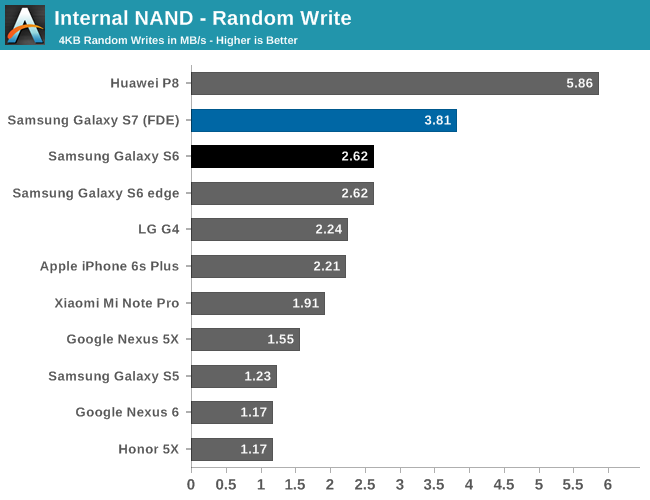
Looking at the performance results, we can also see that the Galaxy S7 is pretty similar to the Galaxy S6 in storage performance at a high level. Interestingly enough despite using full disk encryption on the Galaxy S7, we don’t really see a noticeable degradation in performance relative to the Galaxy S6 which is good to see considering the number of Android devices that do have noticeable performance effects when enabling FDE.










202 Comments
View All Comments
Belard - Friday, March 11, 2016 - link
What I find shockingly stupid is the release of these new $600~900 phones, including the latest Moto X, that DO NOT include USB-C connector?! Its been available since last year.Apple does things quickly, they come out with technology and release it: such as with the iPhone 5 with its reversible port. How hard is it to do with other companies?
Motorola (Lenovo) could have done this with their New X to make a bold statement on how they are going to run their business.
theduckofdeath - Friday, March 11, 2016 - link
Probably because Samsung has usage data on what we actually use the USB port for these days. And I guess it's used almost exclusively as a charger. Why force the consumers to buy a bunch of new cables and chargers just because there is a new port out there? I know Apple would do that in a heartbeat, like you said, as they simply see it as a new way to increase earnings on licensing accessories.Azurael - Tuesday, March 15, 2016 - link
Because USB-C is much easier and quicker to connect? (I certainly find the 5X and 6P much easier to connect in a darkened room - good thing since Google nicked Qi charging.)Because USB-C cables and sockets should be (probably too early to say, but by design) far less prone to failure than Micro-B? (Micro-B cables, and not cheap ones - OEM LG/Nokia/Sony/Moto cables, die on me on a weekly basis. About half of the cables I own only work for charging now.)
I don't know, why don't we still connect our keyboards with the AT connector or PS/2, and our digital video cameras by firewire?
You don't need new chargers. If you've got dozens of USB-A power supplies, just use an A-C cable.
theduckofdeath - Tuesday, March 15, 2016 - link
I'm not suffering from long connection times when connecting my mobile to the charger. Sure, it would be nice with a more uniform connector, but, if it comes at the expense me having to throw away all old cables, having to bring adapters and generally making life more expensive, I can easily live with a micro USB connector until connectors are entirely a thing of the past.Physical connectors for data transfer is really not essential these days. These phones has wifi and LTE connectivity at speeds close enough to any USB connection to make us not bothering transferring anything by wire any more.
Belard - Tuesday, March 15, 2016 - link
Uh, just need to replace the cable or it comes with the phone... not difficult. A flip-able cable is VERY handy, especially in the dark. Unless the end is marked or molded a different shape - you have to LOOK which side is up. Apple changed the cable ONE time, because they wanted a much smaller and better connector.So for a top end phone, I want a state of the art connector too. hence, I bought a new Moto G for $220... I lose the stereo speakers, but I saved $200 and have two free color covers I switch out for when I'm in the mood. So maybe I'll stick with the Gs.
Bruce Dunn - Friday, March 11, 2016 - link
For the average cell phone buyer, most of the information in this review goes right over their heads. I hope that part 2 of the review will address in simple language the following:Can I read the display in direct sunlight (giving me the number of nits emitted by the display does not tell me this).
What happens if I drop the phone into a sink full of water.
What happens if I drop the phone onto a concrete floor.
peedroo - Saturday, March 12, 2016 - link
http://www.displaymate.com/Galaxy_S7_ShootOut_1.ht...Maximum screen brightness in high ambient light results
s.yu - Thursday, March 17, 2016 - link
Anandtech is not for the "average cell phone buyer". It's for people who *really want to know*. If there were more of us there would be less rip-off products on the market and everything would be easier, more money would be devoted to R&D instead of marketing and more will be achieved.peedroo - Saturday, March 12, 2016 - link
Loved the review till nowBut here
http://www.displaymate.com/Galaxy_S7_ShootOut_1.ht...
...they have tottaly diferent results about screen brightness levels when we compair it to the S6. It's better
karthik.hegde - Sunday, March 13, 2016 - link
I think what article needs to highlight more is that the Kirin 950 handily beats SD820 is most of the tests. ARM Cortex-A72 is a great core, released quite sometime ago still doing pretty well. I am sure ARM has new CPUs in the pipeline which will be released soon.I wonder if it makes sense for Qualcomm from business perspective to continue designing their own cores, while ARM already offers stock cores with great performance.